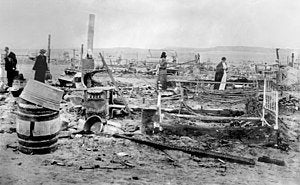
https://www.wikipedia.org/wiki/Ludlow_Massacre
“The massacre was the seminal event of the 1913–1914 Colorado Coalfield War, which began with a general United Mine Workers of America strike against poor labor conditions in CF&I's southern Colorado coal mines.[8] The strike was organized by miners working for the Rocky Mountain Fuel Company and Victor-American Fuel Company. Ludlow was the deadliest single incident during the Colorado Coalfield War and spurred a ten-day period of heightened violence throughout Colorado. In retaliation for the massacre at Ludlow, bands of armed miners attacked dozens of anti-union establishments, destroying property and engaging in several skirmishes with the Colorado National Guard along a 225-mile (362 km) front from Trinidad to Louisville.[6] From the strike's beginning in September 1913 to intervention by federal soldiers under President Woodrow Wilson's orders on April 29, 1914, an estimated 69 to 199 people were killed during the strike. Historian Thomas G. Andrews has called it the “deadliest strike in the history of the United States.”[2]: 1 ”
“The Ludlow Massacre was a watershed moment in American labor relations. Socialist historian Howard Zinn described it as “the culminating act of perhaps the most violent struggle between corporate power and laboring men in American history”.[9] Congress responded to public outrage by directing the House Committee on Mines and Mining to investigate the events.[10] Its report, published in 1915, was influential in promoting child labor laws and an eight-hour work day”
